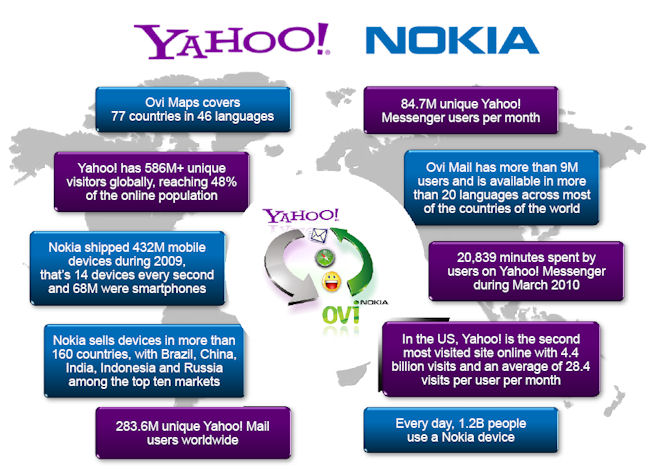The first implementation will appear in the second half of 2010 in selected markets, with the global roll-out happening in 2011. Both companies will continue to use their respective brands and distribution channels. However, the strategic alliance will see Nokia running the back end of Yahoo's maps and navigation related services, while Yahoo will run the back end of Ovi Mail and Ovi Chat.
"Delivering great user experiences -- both online and on your mobile - is what this alliance is all about," said Olli-Pekka Kallasvuo, CEO, Nokia. "We're enabling millions of Yahoo! customers in key markets including North America to discover the unique capabilities that Ovi Maps brings. Similarly, Yahoo!'s online expertise will bring exciting mail and messaging enhancements to millions of Ovi Mail customers across almost every country around the world, many of whom will have their first Internet experience on their mobile."
"What a combination," said Carol Bartz, CEO, Yahoo! "We're excited to expand the reach of our best-in-class Mail and Messenger services, bringing personalized experiences to more people across the mobile web, particularly in emerging markets where we are seeding the next generation of Yahoo! users. At the same time, we believe Nokia's strength and continued investment in maps and navigation will greatly enhance our existing products, enabling us to focus on areas that are core to our business."
Nokia see the alliance as "a logical move by two companies who will be working together to offer consumers the best possible experience". A key piece of thinking behind the alliance is that there is "a lot of 'complementarity' between Yahoo and Nokia: distribution (web versus mobile), geographically (USA versus rest of world), investments (mail and chat versus maps)".
Yahoo has struggled in the last few years in the face of competition from Google, Facebook, Microsoft and many others. Nokia faces increasing competition in the high end mobile space and is widely perceived as having faced some trouble in executing its service strategy. However, there's no doubting the scale of Yahoo and Nokia - globally Yahoo has 586 million unique visitors, while 1.2 billion people use a Nokia device. The alliance may not immediately impact on high end users - the 20%, but could have far reaching implications for the majority market - the 80%. That fits in with the DNA and strategy of both companies, which take a horizontal rather than a vertical approach.
The Maps portion of the deal helps Nokia leverage its Navteq asset and should help build awareness of the Ovi brand in the US market. The alliance may also prove to be particularly significant in developing markets. It is worth noting that the majority of Ovi Mail's 9 million users have signed up to the service on the phone for what is typically their first email account.

The scale of the two companies is evident in the statistics above.
